Asia-Pacific Challenges Meld War, Cooperation
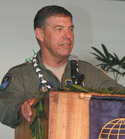 |
| Lt. Gen Daniel P. Leaf, USAF, deputy commander of the U.S. Pacific Command, describes Asia-Pacific challenges amid the Global War on Terrorism to the audience at TechNet Asia-Pacific 2007. |
“We are at war.”
That was the statement made by a
Lt. Gen. Daniel P. Leaf, USAF, the deputy commander of the U.S. Pacific Command, enlarged on his words by saying, “We will win … and we also will win the peace in the Pacific.”
Gen. Leaf urged the leadoff breakfast audience at TechNet Asia-Pacific 2007 to “carry the message to the public.” The annual conference and exposition, held November 5-8 in
And that is a war that will last long and will require a broad-based effort among all elements of society, many of those experts noted. Gen. Leaf expressed astonishment that the public is not more optimistic about the war. The
“Carry the message … we will win,” he declared.
Describing challenges in the Asia-Pacific region as a microcosm of those facing the world as a whole would not be entirely accurate, as that region alone comprises half the globe and more than half of its population. It is not a microcosm, but instead is the major portion of the world with most of its challenges.
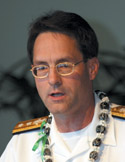 |
| Rear Adm. John M. Bird, USN, deputy commander/chief of staff, U.S. Pacific Fleet, lists the fleet’s top priorities. |
Rob C. Thomas II, executive director of the
Bob Lentz, deputy assistant secretary of defense for information and identity assurance, Office of the Assistant Secretary of Defense for Networks and Information Integration, offered that a security solution is no good if it does not work. He said that security must be an enabler for the warfighter, not an inhibitor.
“We’re in a sprint constantly,” Lentz continued, adding that the U.S. Defense Department must put resources into advancing ahead of technology instead of just pumping money into security. Among the department’s top priorities is assured information sharing—part of keeping ahead of the technology—along with identification management and crypto key management. With 90 percent of defense information technology coming from commercial off-the-shelf sources, the department will need a framework for risk management.
And, the department must protect and defend the network more aggressively. “The enemy understands our tactics, techniques and procedures,” Lentz noted, adding that the gap is closing quickly.
These points were not lost on Col. Kirk Bruno, USMC, commander of the Defense Information Systems Agency (DISA) Pacific. He described satellite systems as “the Maginot Line of the 21st century” and warned that measures must be taken to safeguard satellites or network centricity will not succeed. The Iridium satellite telephony system “has been a lifesaver,” he said, and netted Iridium will be even better.
 |
| Brig. Gen. Ronald M. Bouchard, USA (r), director for communications systems, J-6, U.S. Pacific Command, introduces a J-6 panel session on producing an agile communications environment. Other panelists are (l–r) Linda Newton, deputy chief of staff, N-6, U.S. Pacific Fleet; Col. Michael Lewis, USAF, director of communications, U.S. Pacific Air Forces; Col. Scott Blankenship, USMC, director, G-6, U.S. Marine Forces Pacific; and Col. Michele Bolinger, USA, director, G-3, 311th Signal Command (Theater). |
Network management is the most important task facing the director of communications for Pacific Air Forces. Col. Michael Lewis, USAF, cited the need to dynamically manage command, control, communications and computer (C4) networks to deliver situational awareness to the warfighter. His office has cut personnel numbers and is “bringing people and equipment back” in a business-style consolidation. Virtualization is one possible path, he offered.
Cyberspace may be the only warfighting domain where the United States has peer competition, suggested Lt. Gen. (Sel.) Edward A. Rice Jr., USAF, the vice commander of the Pacific Air Forces. An adversary can come from anywhere in cyberspace, and velocity and precision are as important there as they are on a conventional battlefield. But, unlike some others, Gen. Rice is optimistic about cyberspace. “We stand on the brink of superiority in cyberspace,” he declared.
Delivering vital information has increased in importance with securing it. Rear Adm. Andrew M. Singer, USN, the director for intelligence, U.S. Pacific Command, began a panel discussion by citing the twin challenges of moving homeland security information to civil authorities and of delivering military information to coalition partners.
Col. Timothy Howard, USMC (Ret.), the deputy assistant chief of staff for intelligence, Marine Forces Pacific, described “a Byzantine series of classifications” for determining with whom information can be shared. The military needs to loosen these to conduct effective operations.
“I am death on JWICS [Joint Worldwide Intelligence Communications System] and Top Secret,” he said. “They don’t let us talk with each another.”
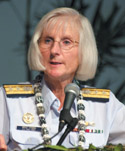 |
| In the Pacific Ocean, the U.S. Coast Guard must interoperate with U.S. and foreign militaries for homeland security and maritime safety, explains Rear Adm. Sally Brice-O’Hara, USCG, commander of the 14th Coast Guard District. |
Col. Howard declared that a significant amount of intelligence does not need to be classified, and this viewpoint was expanded by Col. Steven R. Grove, USA, commander of the 500th Military Intelligence Brigade. Col. Grove noted that open source intelligence is an important element of intelligence, and it is changing the nature of the craft. A new generation of individuals is moving through the ranks with knowledge of and comfort with Web 2.0 technologies and capabilities. They are at ease with open source information, and they are not as culturally reliant on the classified arena and its information, he said.
Col. Grove also noted that the news media are “the front line of collection,” and while many people may not agree with their analysis and slant, it is not necessary to agree with the media’s perspective to find their information useful. He added that the military must fully integrate open-source intelligence into agile all-source intelligence operations.
 |
| Network assurance is an essential element in support to the warfighter, as discussed by a panel comprising (r–l) moderator Bob Lentz, deputy assistant secretary of defense for information and identity assurance, Office of the Assistant Secretary of Defense for Networks and Information Integration; Rob Thomas II, executive director of the Air Force Personnel Center; Col. Christopher Argo, USA, Special Operations Command, Pacific; and Col. Kirk Bruno, USMC, commander, Defense Information Systems Agency Pacific. |
It’s what decision makers and warfighters do not know that can increase regional challenges.
The other main issue is even-more-secretive
But natural disasters loom as immediate challenges. Saying “we’re a 911 force in the Pacific,” Gen. McMillian noted that Indonesia has suffered several major earthquakes recently—all since the 2004 tsunami-generating temblor—and a volcano is about to blow. If bird flu becomes contagious between humans, the loss of life in
The combination of the war on terrorism and recent natural disasters has brought civil authorities and the military into the joint arena. Both groups work at and depend on partnerships with each other as they deal with counterterrorism efforts and disaster relief. But, problems arise even among groups that have worked together before. When cultural differences and vast distances are factored in, major difficulties define many of these attempts at cooperation among civil and military groups.
For example, increases in secure military communications actually decrease cooperation with state and local authorities, as Maj. Jason Sabat,
Echoing his call for a common operational picture was Lt. Col. (P) Stanley Toy,
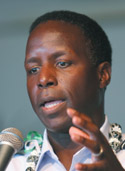 |
| Cyberspace is a contested warfighting domain, according to Lt. Gen. (Sel.) Edward A. Rice Jr., USAF, vice commander of the Pacific Air Forces. |
Her district covers 12.2 million square miles, and search and rescue operations can take days. When a Chinese ship sent a distress call during a typhoon, U.S. Navy P-3 aircraft out of
Industry’s role in the war is vital, as it must produce and speed deployment of effective new technologies to serve warfighters. Gen. Leaf called on industry to be realistic in its work for the military, warning that industry should do what it says it can do without overreaching.
“Don’t promise the moon and then moon us,” he said.
Gen. Leaf specifically directed industry to think about information assurance and the ability to cooperate with allies while protecting
The general cautioned against building down to the lowest common denominator, but he also warned against building up to the highest possible capability. Think broadly about the mission set, he said, because the military does not know what it will be called upon to do next.
Adm. Bird elaborated on the Pacific Fleet’s needs. The fleet needs industry’s technologies to meet its challenges, of which there are many, he said.
Specific requirements include the ability to identify threats with a minimum of effort, a transparent network with multiple security levels, the capability to conduct classified coalition communications over both the secret and nonsecure Internet protocol router networks and communications with submarines at depth and at speed.
 |
| Maj. Jason Sabat, USA (l), Pacific Defense Coordinating Element officer in charge, 196th Infantry Brigade, discusses the need for a common operational picture for the military and state and local authorities for incident management. Other panelists are (l–r) Lt. Col. (P) Stanley Toy, USA, Task Force Homeland Defense, Headquarters, U.S. Army Pacific; Kenneth Tingman, federal coordinating officer, FEMA Pacific Area Office; Ed Teixeria, vice director, Hawaii State Civil Defense; and moderator Brig. Gen. Gary Ishikawa, Hawaii Army National Guard. |
To achieve coalition interoperability, the admiral called for a common language made possible through technology. This interoperability will require an architecture that allows information exchange without violating security issues of each nation.
The Pacific Air Forces need to converge capabilities onto Internet protocol (IP) platforms, Col. Lewis explained. He added that DISA is helping implement voice over secure IP capabilities.
Warfighters want commonality of headquarters and theater technologies, observed Col. Michele Bolinger, USA, director, G-3, 311th Signal Command (Theater). The military still does not have enough satellite communications to support
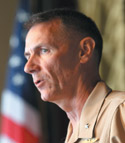 |
| Both geopolitical challenges and natural disasters are ongoing missions for Marine Forces Pacific, according to the deputy commander, Brig. Gen. Rex C. McMillian, USMC. |
Gen. McMillian cited the need for a common set of graphics to generate a common operational picture. Pursuing commonality further, he called for a common set of systems to permit
Photography by Bob Goodwin, Jason Mills and Robert K. Ackerman.




Comments